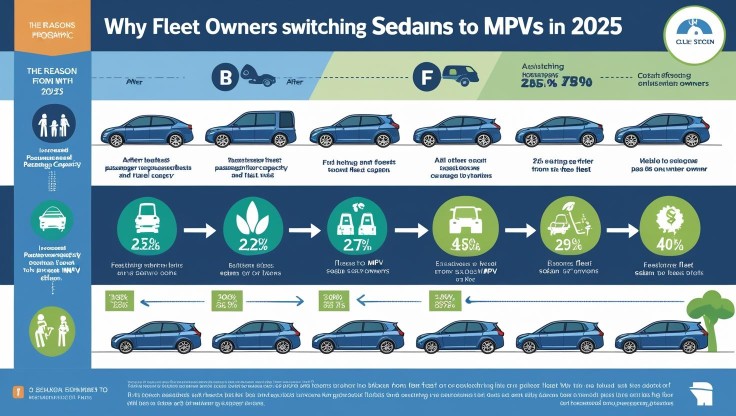
Fleet owners are increasingly ditching sedans for multi-purpose vehicles (MPVs) in 2025 due to a mix of economic, operational, and consumer-driven factors. Here’s a breakdown of the key reasons behind the shift:
1. Higher Seating Capacity = More Revenue
MPVs typically seat 6–8 passengers compared to 4–5 in sedans. For fleet services (like ride-hailing, airport transfers, or corporate shuttles), this means:
-
More passengers per trip
-
Increased fare potential (especially with group bookings)
-
Better cost-efficiency per kilometer
2. Enhanced Comfort and Flexibility
Modern MPVs offer:
-
Spacious interiors with configurable seating
-
Better legroom and headroom
-
More luggage space, ideal for airport or hotel services
This makes them more appealing to both customers and drivers, improving retention and satisfaction.
3. Lower Cost of Ownership (TCO)
Though MPVs often have a higher upfront cost, their total cost of ownership is often lower over time, thanks to:
-
Better mileage per passenger
-
Longer service intervals
-
More durable construction (many built on SUV platforms)
4. Versatility Across Use Cases
MPVs can be used for:
-
Passenger transport
-
Cargo delivery (with seats folded or removed)
-
Tourism, corporate, and VIP services
Their adaptability allows fleet managers to diversify operations with a single vehicle type.
5. Shift in Customer Expectations
Consumers now prioritize:
-
Spacious, SUV-like comfort
-
Shared travel options
-
Family-friendly or group-friendly travel
MPVs deliver a ride experience closer to SUVs, which are more popular in many regions than sedans.
6. EV and Hybrid MPV Options Are Expanding
With the global push for sustainability:
-
More electrified MPVs are entering the market
-
These models often qualify for government incentives, tax breaks, and low-emission zone access
-
They appeal to environmentally conscious corporate clients and urban fleet operators
7. Urban and Regulatory Pressures
In many regions:
-
Cities are phasing out combustion sedans
-
Low Emission Zones (LEZs) prioritize cleaner, multi-passenger vehicles
-
Ride-sharing regulations now favor higher-capacity or electric vehicles
Notable MPVs Gaining Popularity in 2025
-
Toyota Innova HyCross (hybrid, spacious, fuel-efficient)
-
Kia Carnival (premium features for executive transport)
-
BYD e6 / e7 (electric, fleet-focused)
-
Mercedes-Benz V-Class (luxury MPV for high-end fleets)
Bottom Line
MPVs provide better economics, more flexibility, and a superior passenger experience compared to traditional sedans. In 2025, as customer needs and regulatory pressures evolve, MPVs are becoming the new fleet workhorse.
“How to Build a Profitable Fleet Under ₹10 Lakh”

Here’s a practical guide on “How to Build a Profitable Fleet Under ₹10 Lakh” — ideal for aspiring fleet owners or small transport business operators in India.
✅ 1. Define Your Fleet’s Purpose
Start by identifying your niche:
-
Ride-hailing (Ola/Uber)
-
Staff/corporate transport
-
Airport pickups
-
Last-mile delivery
-
Tourist or intercity transport
Your use case determines the right vehicle, financing strategy, and target ROI.
✅ 2. Vehicle Selection: Maximize Value, Minimize Cost
You need vehicles that are:
-
Reliable
-
Fuel-efficient or electric
-
Low on maintenance
-
Passenger- or cargo-capable
🔥 Top Picks Under ₹10 Lakh (2025)
| Vehicle | Type | Fuel | Ex-Showroom Price (₹) | Pros |
|---|---|---|---|---|
| Maruti Ertiga Tour | MPV | Petrol/CNG | ~₹9.8 Lakh | 7-seater, fleet-focused |
| Tata Tigor EV (Fleet version) | Sedan | Electric | ~₹9.5 Lakh | Low running cost, government incentives |
| Maruti Eeco | Van | Petrol/CNG | ~₹6 Lakh | Very low cost, high utility |
| Tata Ace EV / Petrol | Mini Truck | EV/Petrol | ~₹7–9 Lakh | Ideal for delivery/logistics |
| Renault Triber RXE | Compact MPV | Petrol | ~₹6.5 Lakh | Modular seating, good mileage |
✅ 3. Choose the Right Fuel Type
Fuel affects long-term profitability.
| Fuel Type | Best For | Running Cost/km | Pros |
|---|---|---|---|
| CNG | City transport | ₹2–3 | Cheap, low emissions |
| EV | Urban, low-mileage use | ₹1–2 | Government support, low maintenance |
| Diesel | Long-distance | ₹4–5 | Good mileage, torque |
| Petrol | Low upfront cost | ₹6–7 | Easy availability |
✅ 4. Financing Smartly
Don’t burn capital. Use:
-
NBFC auto loans (lower interest for commercial use)
-
Leasing from fleet management firms
-
Government EV subsidies (for electric vehicles)
-
Down payment of 15–20% and EMI structure aligned with monthly cash flow
✅ 5. Essential Fleet Costs Breakdown
| Expense | Monthly Estimate per Vehicle |
|---|---|
| EMI | ₹10,000–₹14,000 |
| Fuel | ₹5,000–₹8,000 |
| Insurance | ₹1,000–₹1,500 |
| Maintenance | ₹1,000–₹2,000 |
| Driver Salary (if employed) | ₹12,000–₹15,000 |
Total monthly cost: ~₹30,000–₹40,000
Target minimum monthly revenue per vehicle: ₹50,000–₹60,000 for solid margins.
✅ 6. Maximize Utilization
-
Double shifts (e.g., morning office + evening ride-hailing)
-
Weekend tourist runs
-
Night rentals (corporate pickups, airport drops)
High utilization = better ROI.
✅ 7. Track Performance Digitally
Use apps or basic fleet management tools to:
-
Track mileage
-
Monitor driver behavior
-
Schedule maintenance
-
Track daily earnings
Bonus Tools: Fleetx, LocoNav, or simple Excel sheets + WhatsApp logs
✅ 8. Register Commercially
Ensure vehicles are registered as commercial with:
-
Yellow plates
-
All India Permit (if intercity)
-
Appropriate insurance
-
Driver with commercial license
Non-compliance can lead to heavy fines or seizure.
💡 Final Tip: Start Small, Scale Fast
Start with 2–3 vehicles, validate profitability, then reinvest profits or attract micro-investors. Your first 10 vehicles under ₹10 lakh each can power a ₹50L+ annual business if managed right.

Sure! Here’s a quick Inshorts-style tip with an icon:
🚗 Fleet Tip of the Day
“Skip sedans, pick MPVs or EVs!”
In 2025, 7-seaters and electric vehicles offer better margins, lower running costs, and higher demand from ride-hailing and corporate clients. Start smart, scale fast.
Here’s an Inshorts-style thank-you note you can add at the end of your blog, complete with an icon:
🙏 Thanks for Stopping By!
Your time means a lot. Whether you’re starting your fleet or scaling one, we’re here to help you drive profits — one smart decision at a time.
🚀 Stay tuned for more insights!
